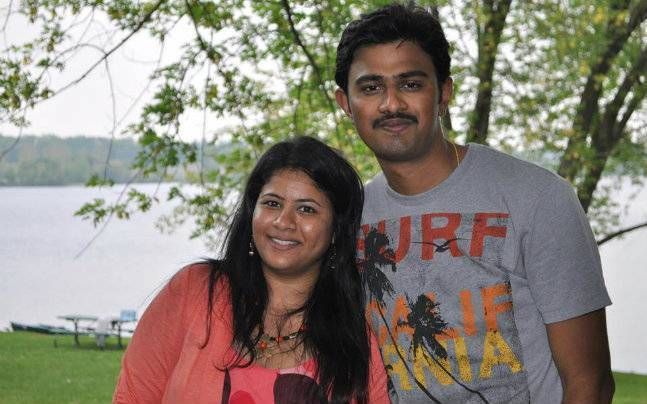
Srinivas Kuchibhotla and his wife, Sunayana Dumala.
The anti-immigrant, hate-driven rhetoric of the present United States administration is transforming to be deadly for the Indian American community, which has carved a home in the silence that accompanies the model minority stereotype that is befitted upon them.
Srinivas Kuchibhotla, a native of Hyderabad, Andhra Pradesh and an engineer by profession, had been sipping a glass of whiskey at Austin’s Bar and Grill in Olathe, Kansas with Alok Madasani, on February 22nd.
A white man approached Kuchibhotla and Madasani, yelled racial slurs at each, mistook the men to be Middle Eastern, and subsequently shot at them — as he allegedly exclaimed, “Get out of my country.” The inflicted wounds proved to be fatal for Kuchibhotla, whose last rites were performed on March 1st. Madasani was released from the hospital on February 23rd.
The murder has sent a ripple across the world. But a major shift is to be noted in the Indian American community. Or, simply within India, generally.
The television is presenting a myriad of Indian faces, who have begun to overtly express the threat to their safety or to the safety of their relatives abroad in the United States. The threat to safety existed for the Indian American community, before the Kuchibhotla incident. The difference exists in the heavily vocalized backlash that has interlaced the events of the past week.
“Racism and xenophobia have been experienced by the Indian American community, even as they remained silent to appease to the white counterpart.”
According to The Economist, “Three-quarters of the Indian-born population in America today arrived in the last 25 years.” The present Indian population, in the United States, totals to more than 3 million, which can be explained from the nearly 147,000 immigrants that India provides to the country on a yearly basis.
The model minority stereotype stems from the “non-threatening nature” of the Indian immigrant — a label bestowed by the white counterpart. The Indian American community is seen as “successful” – a prototype to be followed by fellow minorities. Labels that describe Black or Hispanic immigrants, such as “dangerous,” “unemployed,” or “illegal,” are not applied to the Indian American community or to the larger Asian American community. Instead, they are described as “hardworking,” as 54 percent of Asian Americans in the United States retain a bachelor’s degree.
The stereotype is one that is happily occupied by the Indian American community. There are not quick to express dissent over a political action nor a racist, xenophobic sentiment. There are not quick to express dissent to their host country, the United States, which is pitted as the pinnacle of prosperity. Indian Americans abroad retain a privilege, among the existing minorities. That privilege – which is not to be compared to the magnitude of white privilege – is not a safeguard to the racism nor the xenophobia that is faced regularly by the Black or the Hispanic population, as the murder of Srinivas Kuchibhotla proves.
Yet, racism and xenophobia have been experienced by the Indian American community, even as they remained silent to appease to the white counterpart. The Sikh Gudwara of Oak Creek, Wisconsin witnessed a deadly shooting in 2012 that killed six people, for example.
My estranged father had pulled to the gas station on University Boulevard in Denver, Colorado, on September 11, 2001. He was filling the family Honda Civic with gas, when two white Americans looked at him with great distaste, asking that he “return to where he came from.” He had been mistaken to be Muslim. He reiterated that narrative to me, explaining, “I understood their pain. It is OK that they said that.” I remained quiet.
“In fulfilling the role that the white man had structured for him, my father practiced internalized racism. In fulfilling that role, he showed hate not simply for other minorities but also for himself.”
My estranged father voted for Donald Trump. He had also voted for Mitt Romney. He had voted for conservatives with a known legacy of hate speech against immigrants. My estranged father remained a paradox, in my eye. But, he was fulfilling – to the T – what it meant to be a model minority. He was not to be grouped with fellow Black or Hispanic immigrants; he regarded himself as separate. Perceiving himself as above other minority communities, he would then vote for representatives who pass harmful policies against who should be regarded as allies. In fulfilling the role that the white man had structured for him, my father practiced internalized racism. In fulfilling that role, he showed hate not simply for other minorities but also for himself.
The hate by the majority community is not to be examined. It is to be quietly expressed, among other members of the Indian community. In the confines of a two-story suburban home.
The model minority stereotype renders the Indian American community to be complacent as ally minority communities face discrimination and render that discrimination visible to the public eye. The Indian American community remains silent as ally minority communities are compared to the Asian American community. The Brookings Institution explains, “…holding up one racial or ethnic minority as a ‘model’ can too easily become an implicit criticism of other minorities. ‘If Asians can do it, why can’t you?’ is the thought process lying not far below the surface of some commentaries on race and racism in the U.S.”
When the infamous Muslim Ban was enacted or the border wall, in the month of January, noteworthy support had not been extended from the Indian American nor the Indian community to the minorities that were due to be affected. But, as one of their own was brutally slayed, the opposition is clear. People are denying employment opportunities in known conservative states to avoid what occurred in Kansas. The mother of Srinivas Kuchibhotla even asked for her younger son to not return to the United States.
President Donald Trump, however, has yet to make a statement condemning the incident. It undeniably demonstrates that the model minority stereotype cannot be seen as a protective mechanism against the fear-driven dialogue of the Trump administration.
The model minority stereotype renders Indians abroad to be complacent. To not speak of heavily politicized issues occurring in the United States, to not take a stance. They believe, as a result of their model minority role, that they will be excluded from the violence, the racism, and the xenophobia. The Kuchibhotla incident reiterates that they will not. They cannot be. That their complacency hurts themselves as well as other minority groups that do not see their support.
This post originally appeared in Feminism in India.
